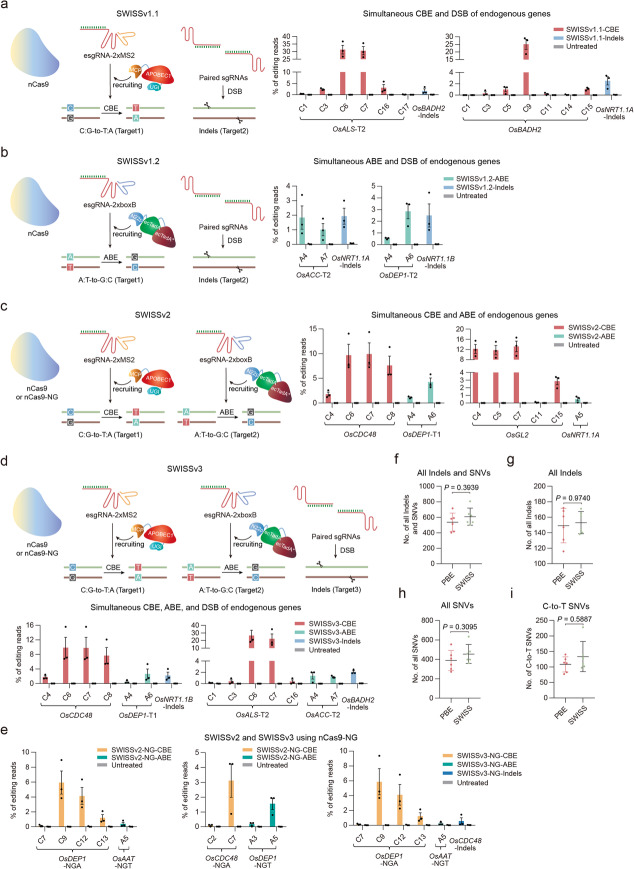Fig. 3.
CRISPR RNA scaffold-programmed simultaneous multiplex genome editing based on an nCas9 (D10A) platform in rice protoplasts. a Simultaneous CBE and DSB formation induced by PBEc4 with esgRNA-2×MS2, and paired sgRNAs. Left, schematic of the SWISSv1.1 strategy. Right, the two sets of sgRNAs tested (n = 3). A CBE target, esgRNA-2×MS2, and paired sgRNAs for creating DSB were assembled in the same vector. b Simultaneous ABE and DSB induced by PABEc5 with esgRNA-2×boxB, and paired sgRNAs. Left, schematic of the SWISSv1.2 strategy. Right, the two sets of sgRNAs tested (n = 3). One ABE target with esgRNA-2×boxB and paired sgRNAs for creating DSB were assembled in the same vector. c Simultaneous CBE and ABE induced by SWISSv2. Left, schematic of the SWISSv2 strategy. Right, the two sets of sgRNAs tested (n = 3). One CBE target with esgRNA-2×MS2 and one ABE target with esgRNA-2×boxB were assembled in the same vector. d Simultaneous CBE, ABE, and DSB induced by SWISSv3. Top, schematic of the SWISSv3 strategy. Bottom, the two sets of sgRNAs tested (n = 3). One CBE target with esgRNA-2×MS2, one ABE target with esgRNA-2×boxB, and paired sgRNAs for DSB were assembled in the same vector. e The scope of SWISSv2 and SWISSv3 multiplex genome editing strategies could be expanded by an nCas9-NG PAM variant. The two sets of sgRNAs for SWISSv2 and one set of sgRNA for SWISSv3 tested (n = 3). Multiple sgRNAs were assembled in the same vector. a–e An untreated protoplast sample served as control. Values and error bars indicate means ± s.e.m. of three independent experiments. f–i Numbers of total indels and SNVs (f), total indels (g), total SNVs (h), and total C-to-T SNVs (i) identified in the PBE and SWISS plants. Both of the pH-SWISSv2/v3 and pH-PBE binary constructs were transformed without the sgRNA cassette. Each dot represents the number of indels or SNVs from an individual plant. Horizontal lines and error bars indicate mean number of mutations ± SD (n = 6). P values were calculated by the two-tailed Mann-Whitney U test

